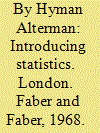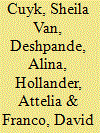|
|
|
Sort Order |
|
|
|
Items / Page
|
|
|
|
|
|
|
| Srl | Item |
| 1 |
ID:
140662


|
|
|
|
|
| Publication |
Princeton, Brandon/systems press, Inc., 1970.
|
| Description |
ix, 181p.hbk
|
| Standard Number |
877690286
|
|
|
|
|
|
|
|
|
|
|
|
Copies: C:1/I:0,R:0,Q:0
Circulation
| Accession# | Call# | Current Location | Status | Policy | Location |
| 005493 | 658.4033/ENR 005493 | Main | On Shelf | General | |
|
|
|
|
| 2 |
ID:
041666


|
|
|
|
|
| Publication |
London, Faber and Faber, 1968.
|
| Description |
256p.
|
|
|
|
|
|
|
|
|
|
|
|
Copies: C:1/I:0,R:0,Q:0
Circulation
| Accession# | Call# | Current Location | Status | Policy | Location |
| 003478 | 519.2/ALI 003478 | Main | On Shelf | General | |
|
|
|
|
| 3 |
ID:
129961


|
|
|
|
|
| Publication |
2014.
|
| Summary/Abstract |
This paper describes results from a network survey of Nain - a predominantly Inuit community of ~1200 people located on the northern coast of Labrador. As part of a larger social network research project, we used peer-referral sampling to recruit 330 residents for interviews about food sharing, housing, public health and community traditions. The peer-referral chains were analysed statistically to determine the presence and absence of social divisions in the community. The results of these analyses show that ethnic identification, relocation status and household income were the most significant social divisions in the community, while gender, education level and employment status show little or no effect on patterns of between-group interconnection. We argue that statistical patterns in the presence (and absence) of intergroup links offer novel ways to examine the interrelationship between recent economic development and the historical disruptions caused by Inuit community relocations in the 1950s.
|
|
|
|
|
|
|
|
|
|
|
|
|
|
|
|
| 4 |
ID:
159759


|
|
|
|
|
| Summary/Abstract |
By means of the latest seven national household surveys of the Democratic Republic of the Congo, this article uncovers the very volatile sampling frame used underneath all survey designs. As a result, the reliability of much associated survey information as well as any corresponding temporal analysis are seriously jeopardized. Relying on recent vaccination, school enrolment and election data, the article proposes a post-stratification technique to retroactively control for these erratic variations in sampling frame in an attempt to identify real socio-economic trends. Although the proposed technique did not restore full comparability of survey data in all respects, it has been able to eliminate an essential part of the spuriousness as illustrated by assessing trends in asset ownership under both the biased and stabilized sampling frames.
|
|
|
|
|
|
|
|
|
|
|
|
|
|
|
|
| 5 |
ID:
126258


|
|
|
|
|
| Publication |
2012.
|
| Summary/Abstract |
Understanding the fate and transport of biological agents into buildings will be critical to recovery and restoration efforts after a biological attack in an urban area. As part of the Interagency Biological Restoration Demonstration (IBRD), experiments were conducted in Fairfax County, VA, to study whether a biological agent can be expected to infiltrate into buildings following a wide-area release. Bacillus thuringiensis var. kurstaki is a common organic pesticide that has been sprayed in Fairfax County for a number of years to control the gypsy moth. Because the bacterium shares many physical and biological properties with Bacillus anthracis, the results from these studies can be extrapolated to a bioterrorist release. In 2009, samples were collected from inside buildings located immediately adjacent to a spray block. A combined probabilistic and targeted sampling strategy and modeling were conducted to provide insight into likely methods of infiltration. Both the simulations and the experimental results indicate sampling entryways and heating, ventilation, and air conditioning (HVAC) filters are reasonable methods for "ruling in" a building as contaminated. Following a biological attack, this method is likely to provide significant savings in time and labor compared to more rigorous, statistically based characterization. However, this method should never be used to "rule out," or clear, a building.
|
|
|
|
|
|
|
|
|
|
|
|
|
|
|
|
|
|
|
|
|